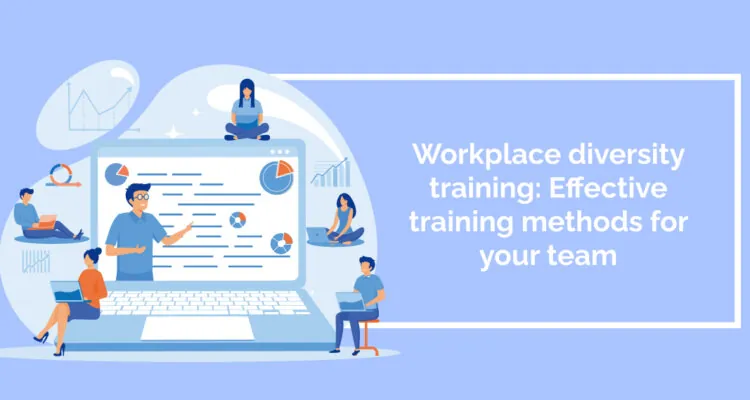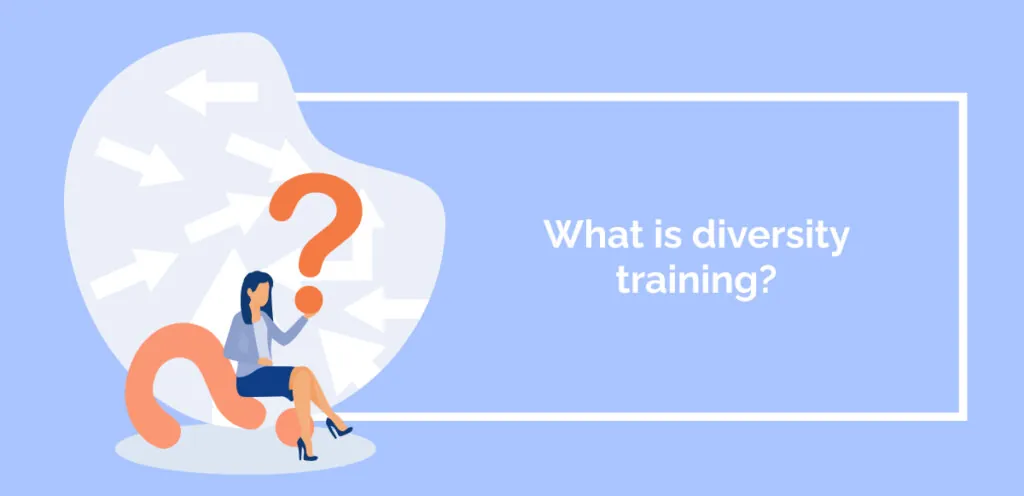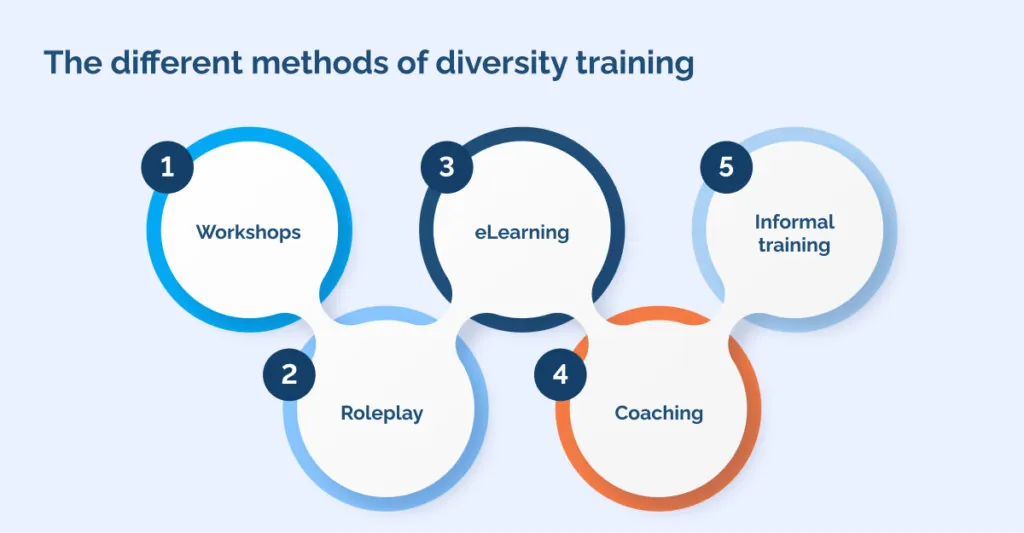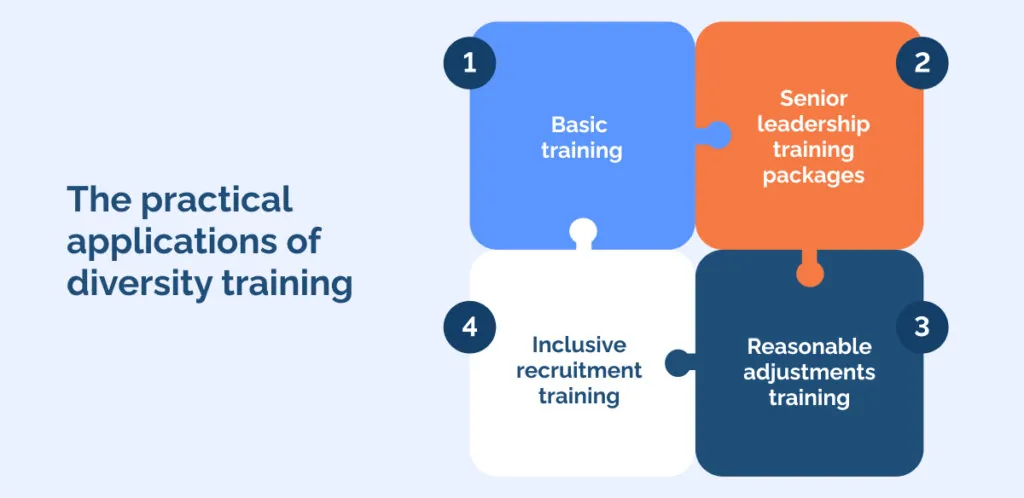
Staff training has a vital role to play in the success of diversity, equity, and inclusion initiatives. It goes along with talent strategy, progression opportunities, and ethical leadership to create a welcoming and encouraging culture of allyship.
This article will introduce you to the basic elements of diversity training for employees. It will:
- Define “diversity training”;
- Discuss the best training methods for delivering diversity training;
- Introduce the specific types of training that can help your business.
By the end, you’ll be in a much better position to know the what, how, and why of diversity training.
What is diversity training?

Diversity training, also known as diversity, equity, and inclusion (DEI) training, is a structured educational program designed to foster an inclusive workplace environment by raising awareness of diversity-related issues and promoting understanding among employees. It aims to cultivate a culture that values and respects differences in race, ethnicity, gender, sexual orientation, age, abilities, and other dimensions of diversity.
Diversity training typically covers topics such as:
- Unconscious bias
- Microaggressions
- Inclusive communication
- Anti-racism
- Gender equality
- Intersectionality
- Resistance and solidarity
- Law and policy
Good diversity training educates participants on the history of discrimination, investigates the challenges that staff face in your company, and rehearses the behaviors that produce a better company culture.
What are the different methods of diversity training?

For methods, you can use many of the skills and techniques that you’d use for any type of training. This section will explain how the following methods are especially useful:
- Workshops
- Roleplay
- eLearning
- Coaching
- Informal training
However, in some ways, you may need to rethink your handling of any method. For the past century, educational writers have shown how common pedagogical techniques simply reproduce the power structures that they ostensibly aim to remove. Keep that in mind when you are planning your program.
Workshops
Many instances of staff diversity training are delivered through a “workshop” of some kind. Workshops are an adaptable style of training. They are usually interactive and participatory, with a small group of participants engaging in discussions, activities, and exercises to deepen their understanding.
For diversity training, workshops play a crucial role in fostering open dialogue, increasing awareness, and building practical skills.
Workshops create a safe space for employees to share experiences, ask questions, and collaborate, promoting a more inclusive workplace culture by actively involving staff in the learning process and encouraging the application of diversity principles in their working life.
Roleplay
Role play is a valuable method of simulation training for delivering diversity training as it allows participants to actively engage with and practice various scenarios related to diversity and inclusion in a controlled setting.
Through role-play, participants can step into the shoes of different characters, experiencing firsthand the perspectives and challenges associated with diverse identities and backgrounds. It can improve empathy, enhance communication skills, and increase cultural awareness.
eLearning
eLearning methods are highly effective in delivering diversity training as they provide a flexible and accessible platform for participants to engage with content at their own pace and convenience. Through eLearning modules, employees can access diverse perspectives, case studies, and interactive exercises that cater to different learning styles.
eLearning courses can be useful for many types of diversity training. A basic set of anti-discrimination tutorials can contribute to employee onboarding or annual mandatory training. More advanced courses on the legal aspects of discrimination or inclusive conflict management training can be a part of leadership development.
Coaching
A coaching plan can significantly contribute to diversity training by providing personalized guidance and support.
Coaches can work one-on-one with employees to address specific challenges, biases, or concerns related to diversity, helping them develop a deeper understanding of their perspectives and behaviors. The coaching process encourages self-reflection, fosters empathy, and assists individuals in all aspects of organizational diversity.
Informal training methods
Informal training methods, inside and outside of the workplace, have a special role in diversity training.
The landscape of diversity and inclusion changes so quickly that it’s hard for formal training methods to keep up. However, plenty of resources explain the ups and downs of discrimination and inclusion in society.
Consuming resources informally can, therefore, give employees the up-to-date information they need. For example:
- Podcasts
- Independent research and reading
- Engaging with social media
- Participation in community events
Make sure you acknowledge this informal work. If you have staff that engage in informal study, they can set the tone for the rest of your company.
What are the practical applications of diversity training?

This section will introduce important examples of diversity training in practice. In particular, we will look at:
- Basic training (also known as awareness training)
- Senior leadership training packages
- Reasonable adjustments training
- Inclusive recruitment training
These interventions can all make use of the methods we described above.
To use any of these approaches successfully, don’t forget that you need to have a slightly deeper knowledge of strengths, weaknesses, and opportunities for diversity and inclusion in your organization.
As 2023 McKinsey research explains, any successful DEI initiative must start with a nuanced understanding of the root causes of your problems. If you don’t understand what’s going on, it will be impossible to introduce good training solutions.
Basic training (awareness training)
Basic diversity training – often known as ‘awareness training’ – is an introductory program designed to provide employees with foundational knowledge and awareness of diversity, equity, and inclusion (DEI) principles.
This training aims to sensitize participants to the importance of understanding and respecting diverse perspectives, backgrounds, and experiences within the workplace. Topics may include recognizing unconscious biases, fostering an inclusive environment, and understanding the impact of diversity on organizational success.
Basic training sets the groundwork for more in-depth diversity initiatives and encourages employees to contribute to a culture of respect and acceptance within the company.
In DEI-positive organizations, basic training will go beyond awareness to skills-based training – in which employees put their work into the practice of empathetic listening, conflict resolution, and more.
How to implement it
By following these steps, organizations can cultivate a workforce with the skills and understanding to create a more inclusive workplace:
- Integrate your training with onboarding. Introduce basic diversity training at the onboarding stage to instill DEI principles from the beginning. If it’s a new initiative, consider making it mandatory for all staff members.
- Maximize eLearning. For widespread delivery, especially in cases where the initiative is mandatory for the entire workforce, leverage eLearning platforms. These can be either outsourced or developed in-house, providing a flexible and accessible training environment.
- Securing leadership buy-in: Gain significant buy-in from management, particularly within HR, to ensure proper funding and support for the training initiative. Leadership endorsement is crucial for the success and sustainability of diversity training programs.
Who’s it for
Everyone in your company should complete awareness training.
Senior leadership training
Senior leadership diversity training is a specialized form designed for executives, top-level managers, and leaders within an organization. The focus is on educating senior leaders about the importance of diversity, equity, and inclusion (DEI) at the highest levels of leadership.
Many C-suite executives will need to improve their understanding of the basics of diversity and inclusion. This training will provide that. There are a range of other topics that senior leaders need to know about, including:
- Understanding the strategic alignment of diversity and inclusion initiatives with overall business goals.
- Recognizing the impact of diversity efforts on the organization’s reputation and external relationships.
- The legal and governance issues involved, ensuring compliance and minimizing litigation risks.
- Making sense of the KPIs, metrics, and measures of accountability for monitoring progress towards diversity goals.
- How to shape and lead inclusive cultures throughout the organization, fostering a sense of belonging from the top to the bottom.
How to implement it
To implement an effective training program for leaders, think about the following steps:
- Only a small number of staff in your organization will need senior leadership diversity training. This means that it may be difficult to build an in-house training capability. Fortunately, many external providers can offer specialist training.
- Some executives will still be struggling with the basic ideas of diversity and inclusion. For those people, reverse mentoring is an innovative approach with a useful impact. Reverse mentoring, as the BBC reported in 2022, has helped the leadership teams of major British companies to understand LGTQ issues, diversity, and the challenges of social mobility.
- Most importantly, HR must insist that diversity training happens. C-suite leaders have a habit of wriggling out of training that they don’t think is important. Today, there is no excuse.
Who’s it for?
You should prioritize staff in key positions, such as HR directors. But in time, everyone involved in line management should have leadership diversity training.
Reasonable adjustments training
Reasonable adjustments are modifications or accommodations made to the work environment, policies, or practices that enable employees with disabilities to perform their job tasks effectively.
Training in this area is an important part of workplace inclusion since it makes a material difference to anyone with a disability. In some cases, adjustments will also be a part of the employer’s legal responsibility.
Topics covered may include recognizing different types of disabilities, understanding the impact of reasonable adjustments on employee performance, and fostering an inclusive culture that values and supports individuals of all abilities.
The goal is to ensure that employees are knowledgeable about and sensitive to the needs of colleagues with disabilities, contributing to a workplace where everyone can fully participate and succeed.
How to implement it
If you have a few staff on hand with training in reasonable adjustments, you will respond to staff needs much more quickly. Use the following steps to make it happen:
- For this kind of training, a third-party provider is the best way to engage staff. They will know and understand the impact that you can make.
- Keep your skills updated regularly. Year after year, organizations have better models for how to accommodate diverse needs. You may need to invest in this training annually.
- Tailor the training to your organization. Reasonable adjustments will be dramatically different if you work in manufacturing, logistics, or office-based work.
Who is it for?
Reasonable adjustments training is a great opportunity for upskilling members of your HR team. In time, it could be rolled out to any diversity champions across the company
Inclusive recruitment
In some areas, integrating DEI into your workplace means making a lot of small changes.
But in others, like recruitment, improving DEI practices takes fundamental changes to hiring processes. Inclusive recruitment training is a specialized program designed to educate hiring professionals and teams on how to do this.
This training aims to eliminate biases in hiring by providing tools and strategies for creating inclusive job postings, conducting fair and unbiased interviews, and implementing equitable hiring practices.
The goal is to build a more diverse and representative workforce by fostering an inclusive hiring environment that values and attracts talent from various backgrounds. It’s a big task, but good recruitment is at the heart of HR best practice today.
How to implement it
Implementing training for inclusiveness will be different depending on several factors.
- If your HR staff are already attentive to DEI issues, Informal learning can be a great starting point. Podcasts, books, blogs, and social media can all furnish examples of the challenges recruits face and the strategies that recruiters can use to improve the experience of applying for jobs.
- However, if your recruitment team is a bit more “old style”, you may be compelled to instate some form of mandatory training.
- If you have an embedded culture of inclusion, you may lean back on eLearning methods.
Who’s it for?
This should be aimed at HR professionals. But it can benefit anyone who participates in hiring.
Nurturing inclusivity through diversity training
Diversity training is one of the most important changes you can make to your company. But at the end of this article, we should remember that it’s just one tactic – and its efficacy is still unproven. Diversity training is not a science. And no methodologies have a proven track record of consistently reducing prejudice and discrimination: as a classic systematic literature review from 2009 shows.
If nothing else, diversity training proves that your company is listening. And when it is fully integrated into everything you do – recruitment, vendor acquisition, handling clients – it can make changes that benefit every member of your organization.
WalkMe Team
WalkMe spearheaded the Digital Adoption Platform (DAP) for associations to use the maximum capacity of their advanced resources. Utilizing man-made consciousness, AI, and context-oriented direction, WalkMe adds a powerful UI layer to raise the computerized proficiency, everything being equal.



